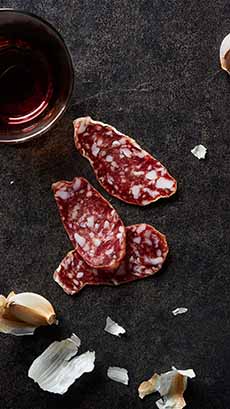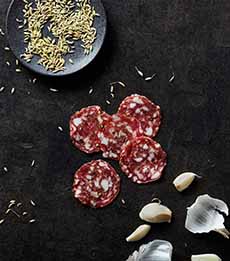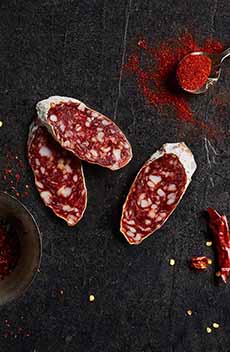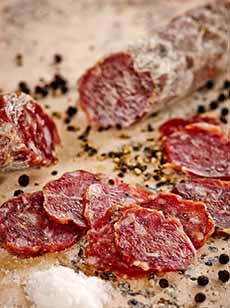Different Types Of Salami For National Salami Day
|
September 7th is National Salami Day, a day to enjoy a slice or two…or more. But while many Americans tend to think of a kosher-style deli salami (photo #10) as “salami,” there are many different types of salami to choose from. For example, pepperoni is a type of salami. So are chorizo, ‘nduja and soppressata. In fact, there are hundreds of types of salami, not just from Italy but from every region. New variations are created each day according to Volpi Foods, which produces several varieties. “That means you could spend your entire life touring the world, one salami at a time, and still never get to try them all,” says Volpi. To explain why there are hundreds of varieties, let’s start at the beginning. Thanks to Columbus Craft Meats, Olli Salumeria Americana, and Volpi Foods for some of the information in this article. > The history of salami is below. The word salami has been around for centuries and is derived from the singular Italian word “salume,” which refers to all types of salted meat. If you find yourself confused over “salami” versus “salume”: salume is singular, and salami is plural. The Oxford Dictionary defines salami as “a type of highly seasoned sausage, originally from Italy, usually eaten cold in slices.” The word originated in Italy from the late Latin word meaning “to salt.” Salami is most often made with pork meat—although other varieties, such as wild boar, duck, and venison exist. Kosher and halal salami are made from beef, and beef and other meats are blended with pork in certain recipes. Salumi (note the “u,” not the “a” in salami) is the category that includes all craft meats, including salami, sausage, and charcuterie. The plural of salumi is salume. Charcuterie is a French term for prepared meat products made primarily from pork, including bacon, ballotines, confits, galantines, hams, pâtés, rillettes, sausages, and terrines. The three main components that set the different types of salami apart are: Salume refers to all Italian meats that are cooked, preserved, or cured*. All salami are salumi, but not all salumi are salami. All salami are sausages at the early stages of production. There are numerous examples of artisanal salami in almost every region of Italy. What follows are some of the varieties that are better known in the U.S. Calabrese Salami. Spicy Calabrese from Calabria gets its kick from cayenne pepper and paprika, making it zesty but not overpowering (photo #11). Italy’s Calabria region is known for its spicy foods. Cacciatore Salami. Cacciatore is Italian for “hunter” (photo #1). The story goes that hunters carried this spicy sausage as a snack on long hunting trips. It can be made with all pork, a pork/beef blend, venison, or wild boar. Coppa. Coppa is not a salami, but it looks like one, marbled with delicious fat. Instead, it is charcuterie, a whole cut of meat taken from a single muscle, pork shoulder that’s typically rubbed with pepper, nutmeg, and allspice. It’s then slowly aged and air-dried for at least 45 days. This brings out its full tenderness and fragrance. It can substitute for prosciutto, which is cured from the pig’s hind leg. Hot coppa (photo #12) is rubbed with crushed red pepper flakes and paprika. Genoa Salami. Genoa Salami is a hard, garlic-heavy, dry-cured meat from Genoa in the Liguria region of northwestern Italy (photo #9). It’s typically made of pork, salt, garlic, pepper, fennel seeds, and wine. Finocchiona Salami. Finocchiona Salami is a spicy Tuscan specialty that is dry-cured and made with fennel seeds and black pepper (photo #3). Hard Salami. A dry, smoky salami seasoned with garlic, salt, white pepper, and red wine with a characteristic fermented flavor. Italian Dry Salami. A rich salami, coarsely ground, flavored with Italian-style seasonings, garlic, and red wine with a characteristic fermented flavor. Milanese Salami. Milanese salami, also known as Milano salami, is made with a combination of pork and beef, and rice-sized grains of pork fat and is bright red in color and sweeter than Genoa salami. Napoli Salami. The traditional smoked salami from Naples, Napoli salami is smoked over applewood giving it a complex, hearty flavor. ‘Nduja. ‘Nduja is a spicy, spreadable salami from Calabria (photo #5). a href=”https://blog.thenibble.com/2016/11/04/tip-of-the-day-nduja/”>Here’s more about it. Pepperoni. Pepperoni is not Italian in origin, but an Italian-American variety of salami, seasoned with chiles and spices. A popular American pizza topping, it can be enjoyed on sandwiches, with cheese, or sliced and served on a charcuterie board. Salami Cotto. Salami cotto, a specialty of the Piedmont region of Italy, is a variety of salami that is cooked before or after curing and is seasoned with garlic and peppercorns. Toscano Salami. This Tuscan specialty is made with wild Tuscan fennel, which, imparts a slight, licorice-like aroma and flavor (p. Chorizo. Chorizo is a type of pork sausage originating on the Iberian Peninsula (photo #2). It is made in many regional varieties and in several countries on different continents, most notably Mexico. Mexican chorizo is made with fresh (raw, uncooked) pork and seasoned with vinegar and chiles. Spanish chorizo is usually made with smoked pork seasoned with garlic and pimentón (Spanish smoked paprika, either sweet or hot—the pimentón gives Spanish chorizo its deep brick-red color and smoky flavor. Spanish chorizo is available in fully cooked and dry, to be sliced like salami/pepperoni;, and fully cooked and soft (semicured). French Salami. Saucisson sec is the French term for dry salami. It’s a thick dry cured sausage made of pork, or pork blended with other meats. Saucisson sec may also be made with additional ingredients such as dried fruits, wine, or cheese to create a distinctive flavor and aroma. There are numerous regional differences. Rosette de Lyon (photo #6), for example, is a dry sausage that consists of coarsely chopped pork, often from the shoulder, with fat, spices, and a hint of garlic. German Salami. German salami is traditionally made with a mixture of pork and beef and seasoned with garlic and spices. It’s typically higher in fat than other salamis. Hungarian Salami. Hungarian salami is made from pork meat and fatty pork bellies. The Pick Company from Szeged, founded in 1869, makes the best-known variety of winter salami. It is known for its cover of white-gray mold, a harmless mold (think Brie and Camembert) that helps to preserve the salami and keep it moist. Spanish Salami. Spanish salami, called salchichon, is a spicy salami made with finely ground pork and beef, and seasoned with peppercorns. > The different types of charcuterie: a glossary. > The different types of bacon. The concept of curing and preserving meat dates back thousands of years. In ancient times, people discovered that salting, drying, and fermenting meat helped to extend its shelf life, making it a valuable food source, especially during the winter months or for consumption on long journeys. The Romans are often credited with refining the art of meat preservation. They used a combination of salt, spices, and natural fermentation to create a variety of cured meat products. In Roman times, these meats belonged to a group of food called salsum, meaning “salted.” Even in prehistoric times, salt was known to be an indispensable way to preserve meat. Salt naturally expels water and blocks the proliferation of bacteria. Toward that end, some modern salume, like sopressata and sausages, belong to the category of air-cured pork meats called salumi insaccati (“encased”), which means that the meat is wrapped in natural skin, usually made from pig intestines. Italy is arguably the most famous producer of salami in the world. Various Italian regions have their own traditional types of salami: Calabrese salami, Genoa salami, Milano salami, Toscano salami, and others noted above. During the Middle Ages, the practice of making salami and other cured meats spread throughout Europe. As in Italy, different regions in different countries developed their own variations of salami. Each had its own unique combination of flavors and ingredients, which were based on available resources and local customs. |
|
|
|
Italian immigrants played a significant role in introducing salami to the Americas, where it became popular in countries like the United States and Argentina. The Industrialization Of Modern Salami In the 19th and 20th centuries, advances in food processing and manufacturing techniques led to the industrial (mass) production of salami. This made salami more widely available and affordable to a broader audience. Modern salami production involves the careful selection of meat cuts, mixing the chopped or ground meat with spices and fat, curing, and fermentation. The specific ingredients and processes can vary widely, and some artisanal producers still rely on traditional methods. Salami has become a global food, enjoyed in various forms and dishes worldwide. It’s commonly found on charcuterie boards, in sandwiches, in pasta, and on pizza, among other culinary creations. One can find a wide range of salami flavors, from traditional to experimental. Some producers create unique combinations by adding ingredients like wine, cheese, herbs, nuts, or even fruits to the mix. How about lamb, juniper, and gin salami seasoned with orange peel and coriander, two of the botanicals in gin? A saucisson rouge nose-to-tail pork salami with the pig’s liver and heart in addition to its flesh? Blackberry duck salami with blackberries, cinnamon, orange peel, and boysenberry sour ale? Dodge City salami salami seasoned with lots of pepper, garlic, and fennel pollen that aims to create a porchetta-like explosion of flavors in your mouth? Spruce & Candy salami with spruce tips, American Pale Ale, lemon peel, clove, Calabrian pepper, and pink peppercorns? We could go on and on. But perhaps the next step is for you to hit the store and pick up some good salami. *Curing is any of various food preservation and flavoring processes of foods such as meat, fish, and vegetables, by the addition of salt. Salt draws moisture out of the food. This occurs by the process of osmosis, which in turn draws out potentially harmful bacteria. With moisture removed, potential new bacteria lose a favorable environment in which to thrive, and the longevity of the food item is increased. CHECK OUT WHAT’S HAPPENING ON OUR HOME PAGE, THENIBBLE.COM.
|
||














